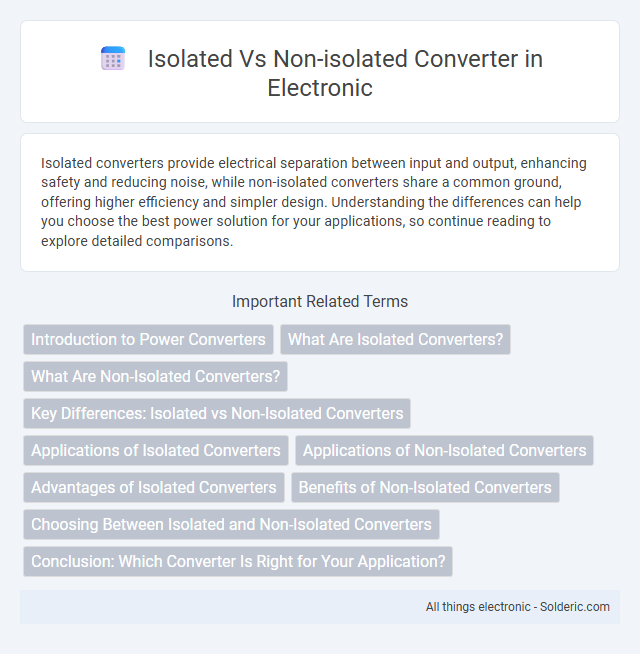Isolated converters provide electrical separation between input and output, enhancing safety and reducing noise, while non-isolated converters share a common ground, offering higher efficiency and simpler design. Understanding the differences can help you choose the best power solution for your applications, so continue reading to explore detailed comparisons.
Comparison Table
| Feature | Isolated Converter | Non-Isolated Converter |
|---|---|---|
| Galvanic Isolation | Provides full galvanic isolation between input and output | No galvanic isolation; input and output share a common ground |
| Safety | Higher safety for sensitive applications, medical, and industrial | Limited safety; potential ground loop issues |
| Complexity | More complex design with transformers or optocouplers | Simpler design, fewer components |
| Cost | Generally higher due to isolation components | Lower cost |
| Noise Immunity | Better noise suppression due to isolation | More susceptible to noise and interference |
| Size | Typically larger size because of transformers | Smaller and more compact |
| Applications | Medical devices, industrial controls, high-voltage circuits | Consumer electronics, low-voltage DC/DC converters |
Introduction to Power Converters
Isolated power converters provide galvanic isolation between input and output, enhancing safety and reducing noise interference in sensitive applications. Non-isolated converters offer direct electrical connection, enabling higher efficiency and reduced size but lack isolation, making them suitable for low-voltage applications. Key types include isolated DC-DC converters like flyback and forward converters, and non-isolated buck, boost, and buck-boost converters used in various power management scenarios.
What Are Isolated Converters?
Isolated converters use galvanic isolation to separate input and output grounds, preventing direct electrical connection and enhancing safety and noise immunity. They typically incorporate transformers or optocouplers to achieve this isolation, making them ideal for applications requiring protection against high voltages or sensitive electronics. Common uses include industrial power supplies, medical devices, and telecom systems where isolation is critical for device protection and signal integrity.
What Are Non-Isolated Converters?
Non-isolated converters are power supply devices that share a common ground between the input and output, providing a direct electrical connection without galvanic isolation. These converters are typically used in applications where voltage levels need to be stepped up or down efficiently, such as in DC-DC buck or boost converters. Their simpler design often results in higher efficiency, lower cost, and reduced size compared to isolated converters, making them ideal for low-voltage, low-noise, and cost-sensitive applications.
Key Differences: Isolated vs Non-Isolated Converters
Isolated converters provide electrical separation between input and output through transformers, enhancing safety and noise immunity in sensitive applications. Non-isolated converters share a common ground, offering higher efficiency, smaller size, and lower cost but with less protection against electrical faults. Your choice depends on requirements for safety, isolation, and complexity in power management designs.
Applications of Isolated Converters
Isolated converters are widely used in industry sectors requiring safety and noise immunity, such as medical devices, telecommunications, and industrial automation. These converters provide galvanic isolation that protects sensitive electronics from high voltages and reduces electromagnetic interference (EMI), ensuring reliable operation in harsh environments. Applications also include renewable energy systems and electric vehicle chargers, where isolation is critical for user safety and system integrity.
Applications of Non-Isolated Converters
Non-isolated converters are widely applied in scenarios where efficiency, compact size, and cost-effectiveness are prioritized, such as in point-of-load regulation for microprocessors, battery-powered devices, and DC motor drives. These converters are integral to power management systems in telecommunications, automotive electronics, and consumer gadgets due to their direct electrical connection between input and output, which minimizes power loss. Your choice of a non-isolated converter facilitates streamlined power conversion in low-voltage environments without the complexity of isolation components.
Advantages of Isolated Converters
Isolated converters provide enhanced safety by physically separating input and output circuits, reducing the risk of electric shock and equipment damage. They offer improved noise immunity and reduce electromagnetic interference due to galvanic isolation, which is crucial in sensitive electronic applications. Isolation also enables multiple ground references and facilitates easier fault protection and system design flexibility.
Benefits of Non-Isolated Converters
Non-isolated converters offer higher efficiency and compact design due to their simpler circuitry without isolation components like transformers. These converters are cost-effective solutions ideal for applications where safety isolation from the input source is not critical. You can benefit from faster transient responses and lower power losses, making them suitable for point-of-load power regulation in tightly integrated systems.
Choosing Between Isolated and Non-Isolated Converters
Choosing between isolated and non-isolated converters depends on your application's safety, noise isolation, and ground referencing requirements. Isolated converters provide galvanic isolation, preventing ground loops and enhancing protection in sensitive or high-voltage systems, while non-isolated converters are more efficient, compact, and cost-effective for applications with common ground. Assessing factors like voltage levels, system complexity, and electromagnetic interference will guide your optimal converter choice.
Conclusion: Which Converter Is Right for Your Application?
Choosing between an isolated and non-isolated converter depends on your application's requirements for safety, noise immunity, and voltage levels. Isolated converters provide galvanic isolation, enhancing protection and reducing electrical noise, making them ideal for sensitive or high-voltage environments. Your decision should balance the need for isolation against factors like cost, efficiency, and complexity to select the converter that best fits your system's specifications.
isolated vs non-isolated converter Infographic

 solderic.com
solderic.com